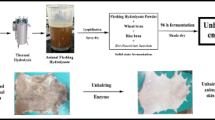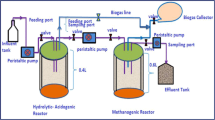Abstract
Generation of solid waste is inherent to manufacture of leather from skin and hide. Solid wastes generated at various unit operations of the tanning process considerably vary in quantity and composition. Fleshing is a type of animal tissue waste generated during the preparatory leather processing stage in relatively larger quantities as compared to other types of solid waste in the tanning industry. Fleshing mainly contains fat and protein and residual chemicals such as lime and sulphide used in the ‘unhairing’ process of beam house operation. Another type of solid waste in tanning industry which requires safe disposal is the primary sludge from tannery wastewater treatment plant. This study shows that both fleshing and primary sludge contains a significant quantity of volatile solids amenable for biodegradation. Different proportions of waste fleshing and primary sludge were subjected to anaerobic digestion. The studies were carried out in a laboratory scale reactor with an aim of developing an appropriate technology for recovery of bioenergy from the waste and subsequently ensure their safe disposal. Volatile solid destruction between 41 and 52%, specific gas production between 0.419 and 0.635 l/g volatile solids feed and methane yield between 71 and 77% were achieved. Further, the biomethanation potential of animal fleshing and substrate specific kinetics of the reaction process were also examined.














Similar content being viewed by others
References
APHA (1998) Standard methods for the examination of water and wastewater. American Public Health Association, Washington DC
Borja R et al (1995) Kinetic evaluation of an anaerobic fluidised-bed reactor treating slaughterhouse wastewater. Bioresour Technol 52:163–167
Chin K-J, Janssen PH (2002) Propionate formation by Opitutus terrae in pure culture and in mixed culture with a hydrogenotrophic methanogen and implications for carbon fluxes in anoxic rice paddy soil. Appl Environ Microbiol 68:2089–2092
Coates JD et al. (1996) Simple method for the measurement of the hydrogenotrophic methanogenic activity of anaerobic sludges. J Microbiol Methods 26:237–246
El-Mashad HM et al (2004) Design of a solar thermophilic anaerobic reactor for small farms. Biosyst Eng 87:345–353
Fulford D (1988) Running a biogas programme—a handbook, Appendix IV, Model for biogas digestion. Intermediate Technology Publication, London, pp 151–159
Gavala HN et al (2003) Mesophilic and thermophilic anaerobic digestion of primary and secondary sludge. Effect of pre-treatment at elevated temperature. Water Res 37:4561–4572
Held C et al (2002) Two-stage anaerobic fermentation of organic waste in CSTR and UFAF-reactors. Bioresour Technol 81:19–24
Isa MH et al (1993) Methanogenic activity test for study of anaerobic process. Indian J Environ Health 35(1):1–8
Jawed M, Tare V (1996) Methanogenic activity and performance of UASB, DSFF and USFF reactors. Water Sci Technol 34:483–487
Mahmoud N et al (2004) Anaerobic stabilisation and conversion of biopolymers in primary sludge-effect of temperature and sludge retention time. Water Res 38:983–991
McCarty PL, Mosey FE (1991) Modeling of anaerobic digestion processes (a discussion of concepts). Water Sci Technol 24:17–33
McHugh S et al (2003) Methanogenic population structure in a variety of anaerobic bioreactors. FEMS Microbiol Lett 219:297–304
Oliveira SVWB et al (2004) Formaldehyde degradation in an anaerobic packed-bed bioreactor. Water Res 38:1685–1694
Parawira W et al (2004) Anaerobic batch digestion of solid potato waste alone and in combination with sugar beet leaves. Renew Energy 29:1811–1823
Parker WJ (2005) Application of the ADM1 model to advanced anaerobic digestion. Bioresour Technol 96:1832–1842
Ramanujam RA et al (2002) Biomethanation—Technological Amenability for sustainable solid waste management in tanneries, 36th LERIG
Saravanabhavan S et al (2004) Natural leathers from natural materials: progressing toward a new arena in leather processing. Environ Sci Technol 38:871–879
Song YC et al (2004) Mesophilic and thermophilic temperature co-phase anaerobic digestion compared with single-stage mesophilic and thermophilic digestion of sewage sludge. Water Res 38:1653–1662
Soto M et al (1993) Methanogenic and non-methanogenic activity test. Theoretical basis and experimental set-up. Water Res 27:1361–1376
Stahl DA (1995) Use of fluorescent probes for determinative microscopy of methanogenic archaea. In: Sowers KR, Schreier HJ (eds) Archaea: a laboratory manual. Methanogens. Cold Spring Harbor Laboratory Press, Cold Spring Harbor, NY, pp 111–121
Visser FA et al (1991) Diversity and population dynamics of methanogenic bacteria in a granular consortium. Appl Environ Microbiol 57:1728–1734
Zellner G et al (1993) Biofilm formation on polypropylene during start-up of anaerobic fixed-bed reactors. Biofouling 6:345–361
Author information
Authors and Affiliations
Corresponding author
Rights and permissions
About this article
Cite this article
Thangamani, A., Rajakumar, S. & Ramanujam, R.A. Anaerobic co-digestion of hazardous tannery solid waste and primary sludge: biodegradation kinetics and metabolite analysis. Clean Techn Environ Policy 12, 517–524 (2010). https://doi.org/10.1007/s10098-009-0256-x
Received:
Accepted:
Published:
Issue Date:
DOI: https://doi.org/10.1007/s10098-009-0256-x




